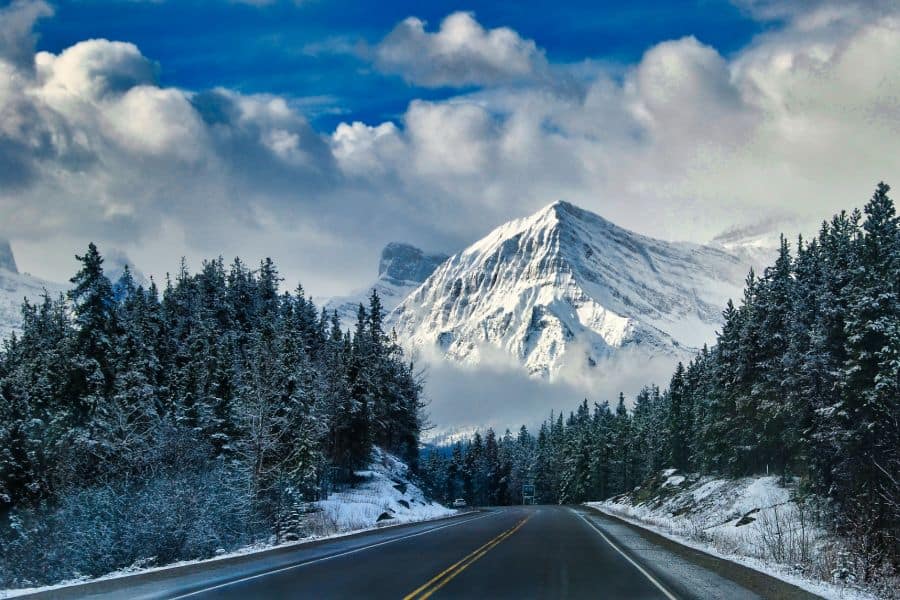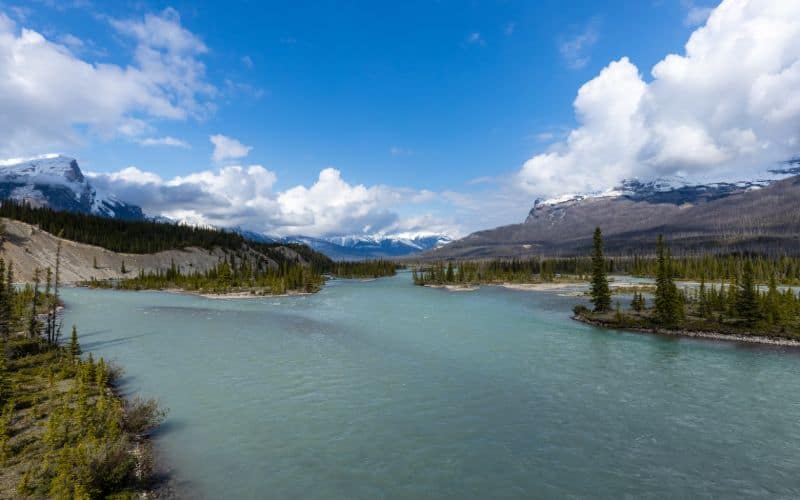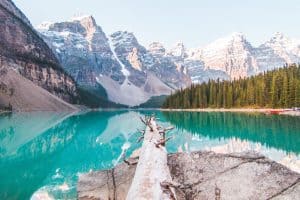- TRAVEL GUIDES
arrow_drop_down
- Canada
- United States
- Sunny Destinations
arrow_drop_down
- VIEW ALL
- BUCKET LIST
- ABOUT
- CONTACT
Epic Views Ahead: 15 Icefields Parkway Stops You Can’t Afford to Miss
- Travel
-
May 02
- Share post

The Icefields Parkway is one of the most scenic drives in all of North America.
Made up of some of Canada’s most breathtaking glaciers and mountain ranges, it’s often coined the “most scenic drive in the world”.
Towering icebergs and grizzly bears will make you feel like you’re living in a painting, but they’re just part of what makes this road so spectacular.
The following article shares some essential information for your trip and points of interest to help create your perfect itinerary to the Icefields Parkway.
Icefields Parkway Road Trip Itinerary
icefields parkway, banff
1. Hector Lake
Your first stop on the Icefields Parkway will be Hector Lake, one of the lesser-known and largest natural bodies of water in Banff National Park.
If you wish to stretch your legs, there’s an easy hike that goes around the lake and is about 5 km long.
Make sure to admire the beautiful landscape, including the Pulpit Peak and Crowfoot Mountain that frames Hector Lake.
2. Bow Lake
Bow Lake is a stunning turquoise body of water reminiscent of nearby Moraine Lake.
Treat your eyes to the panoramic landscape from the edge of the lake, including Crowfoot Glacier (not surprisingly is shaped like the foot of a crow), Wapta Icefield, Bow Glacier, Crowfoot Mountain, and Mt. Thompson.
You’ll also find picnic areas, hiking trails, and a restaurant to enjoy your stop.

3. Peyto Lake & Bow Summit
Peyto Lake was formed from melting glaciers and continues to grow in size.
In the summer, you can see glacier rock flour flow (fine-grained particles of rock) into the bright turquoise lake, giving Peyto Lake its color.
At 2,088 meters above sea level, Bow Summit is the highest point along the Icefields Parkway.
If you hike up, you’ll be greeted with picturesque views of Peyto Lake below and the surrounding area.
4. Mistaya Canyon
Mistaya Canyon is generally less visited than the other stops on the itinerary, but that doesn’t mean you should skip it!
The canyon is accessible through a beautiful forest and a wooden bridge.
Mistaya Canyon has multiple waterfalls, unique rock formations, and gushing water from the Mistaya River.

5. Saskatchewan River Crossing
The Saskatchewan River Crossing is where the Mistaya, the Howse, and the North Saskatchewan rivers connect.
It’s a great place to stop, stretch your legs, and refill your munchies stash at the gas station or have a quick meal at the nearby restaurant.
The Saskatchewan River Crossing is usually the starting spot for tours on the Columbia Icefield as well.
If the weather is nice, enjoy a meal outside while you gaze at the Canadian Rockies that tower over you.
6. Weeping Wall
This waterfall is at Cirrus Mountain and resembles a river of tears on the mountainside on the way to Jasper.
The water cascades into several waterfalls at a height of more than 100 meters (330 feet) high, with the main waterfall called Teardrop.
If you go in the winter, you will find the tears have frozen into towering ice pillars, making it a great spot to ice climb.
7. Big Hill & Big Bend
There is no way you’ll miss Big Hill and Big Bend during your road trip.
The descending road sits tight against the mountain wall on one side, with sweeping views of the valley and river down below on the other side.
Big Bend is a very famous hairpin turn that circles the towering peaks. If you do stop, make sure you pull completely off the road so cars can pass safely.
In wintery conditions, the pavement gets quite icy, so be extra cautious behind the wheel.
8. Bridal Veil Falls
Bridal Veil Falls is a tall cascade that’s visible right on the roadside and an easy pullover stop with a dedicated parking lot.
The waterfall is 370 meters (1,200 feet) tall and is best seen in the spring.
Most of the falls will be frozen over if you visit during the winter, and the water won’t be more than a trickle.

9. Columbia Icefields
For many, the Columbia Icefield is the main stop between Banff and Jasper.
This massive icefield can get up to seven meters (275 inches) of snow every year and is the largest icefield that’s south of the Arctic Circle.
During the summer, you can take a snowcoach bus on top of a glacier, and in the winter, you can participate in ski mountaineering.
Be sure to stop by the Columbia Icefield Discovery Center – you’ll find hiking trails, picnic tables, and a restaurant to refuel your energy.
Tip: The Columbia Icefield’s weather can be unpredictable, and temperatures are cooler than the rest of the area. Bring extra layers and be prepared for the worst.
10. Glacier Skywalk
The Glacier Skywalk is one of the newer experiences in the area that opened in 2014.
You’ll stand on a glass-floored observation platform that is a dizzying 280 meters (918 feet) over the Canadian Rockies and Sunwapta Valley.
Be warned this is not for those who are afraid of heights!

11. Sunwapta Falls
Sunwapta Falls has a staggering drop of about 18 meters (60 feet) and is fed by the Athabasca Glacier.
If you want to hike, there are several trails of varying difficulty that leads to one of the most gratifying views in the area.
This hike is most impressive in late spring and early summer when the snow is melting.
12. Wilcox Pass Hike
Just when you thought things couldn’t get any better, the Icefields Parkway keeps surprising you.
Take a breath of the wild on the Wilcox Pass Hike, full of wildlife such as bighorn sheep and goats.
A strategically placed pair of red chairs welcome you to relax and soak in the astounding views of the mountains and open meadows.
13. Parker Ridge Trail
Nothing beats chasing waterfalls in the Canadian Rockies, and Parker Ridge scratches that itch, and then some.
This is an excellent quick hike that rewards you with stunning views if you’re short on time.
Tip: There may be snow on the trail year-round, so be sure to come prepared. Also, this is a really popular trail so start your hike as early as possible!
14. Athabasca Falls
Athabasca Falls is one of the most powerful falls in the Canadian Rockies, carving unique rock formations and the water flows down.
You can easily view the impressive Athabasca Falls from the many viewing platforms and hiking trails.
The trail here is one of the easiest and busiest hikes in Jasper National Park.

15. Valley of the Five Lakes
The last stop on your Icefields Parkway itinerary is a hike through the Valley of the Five Lakes, a 4.5 km loop trail that takes about 1.5 to 2 hours to complete.
As the name suggests, your hike will show off five beautiful lakes that are in various shades of clear jade and blue.
The most popular lakes to see are the 3rd and 4th lakes, but all of them are very gorgeous.
The unique hue of the lakes comes from the glacier rock dust and special algae in the water.
Best Time to Visit the Icefields Parkway
icefields parkway in winter
The best time to visit the Icefields Parkway is in the summer, from June to August, when the average temperature is around 20 C.
The Canadian Rockies have unpredictable weather, so it’s best to be ready for anything!
Even in the summer months, it’s normal to experience cold weather, including possible rain or even snow in the higher elevations.
In the winter months, from December through February, the average high is around -5 C, with average lows around -15 C.
Park Pass for the Icefields Parkway
bow lake lookout, icefields parkway
The National Park Pass for driving through Icefields Parkway is a requirement, even if you drive straight through.
If you don’t buy a pass and get caught, you can pay a hefty fine.
You can buy a pass at the information center in Banff, Lake Louise, and Jasper.
- For adults (18 to 64 years), a daily pass is $11.
- For seniors (65 years or older), a daily pass is $9.50.
- For youths (up to 17), a daily pass is free.
For families or groups of up to seven in a single vehicle, a single day pass is $22.
Tips for Driving the Icefields Parkway
icefields parkway scenic drive
From food to weather, there are plenty of things you should know about visiting the Icefields Parkway.
Here are some tips to have the best possible adventure while driving the Icefields Parkway:
Stop for Gas Beforehand
Although Saskatchewan Crossing does have a gas station, its isolated location means the station often has the most expensive prices in the province.
Either fill up in Banff before you enter the national park or in Lake Louise, at the start of the Icefields Parkway.
At the end of the drive, you can also refill in Jasper if needed.
Bring Your Own Food
As many stops on the Icefields Parkway offer picnic tables, you’ll have plenty of beautiful locations to eat your lunch or dinner at.
There’s food available at Saskatchewan Crossing and Icefields Visitor Center as well, but the lines can be long, especially in the summer.
Buy a Park Pass
Unlike driving on the Trans Canada Highway through a national park, where you do not need a park pass, the Icefields Parkway requires a park pass.
Yes, even if you don’t make any stops, you’ll still need a pass. Hefty fines can occur if you drive without a pass.
Drive at Your Own Risk in the Winter
Because of the large amounts of snow the Icefields Parkway gets every year, it’s strongly recommended that you only drive through if you are used to driving in snow and icy conditions.
No salt is used to help melt the ice and snow on the road here.
Winter conditions are between November to April and if you’re driving during this time, make sure your car is equipped with winter tires; it’s required by law during this season.
Also note that all restaurants, accommodations, and the Saskatchewan Crossing gas station is closed in the winter.
Drive Through in Both Directions
If time permits, you should drive in both directions on the Icefields Parkway.
You’ll get two stunning drives and can stop at more places than if you just drove in one direction.
For a unique experience, spend a night at the Saskatchewan Crossing in the middle of the Canadian Rockies.
What to Bring & Wear
person looking at the canadina rockies
If you’re visiting in the winter or snowy months (November to April), you’ll need snow boots and a very warm coat rated for -30 C.
Any warm outfit accessories are a must, from hats to mittens, turtlenecks, and wool socks.
Disposable pocket warmers are also something you might want to bring to make your visit more comfortable in the cold weather.
If you’re visiting in the summer and fall months (May to October), layers are key. Temperatures can vary wildly due to elevation changes.
For example, a light sweater can get you through the day in the town of Banff, but if you venture out to Peyto Lake, you’ll likely need something warmer.
It’s much easier to add and remove layers when needed than to lug a heavy winter coat around.
And no matter when you visit, hiking shoes are a must!
Where to Stay NearBY
icefields parkway during sunset
Most people drive through the entire Icefields Parkway in one day and are staying in Banff or Jasper.
However, there are also several hotels along the way if you want to extend your trip and not rush the drive.
The most well-known is the Crossing Resort at the Saskatchewan Crossing.
This hotel has an on-site restaurant, a general store, and a gas station.
Some other hotels in the area include Num-Ti-Jah Lodge, the Sunwapta Falls Resort, and Glacier View Lodge.
Final Thoughts
You’ve made it to the end of the Icefields Parkway adventure! This scenic route through the Canadian Rockies is an absolute gem. From turquoise lakes to massive glaciers, it dazzled at every turn.
But don’t hang up your hiking boots just yet; Banff National Park, the crown jewel of this region, has so much more in store.
Check out our 4-Day Itinerary to the Canadian Rockies to start planning your next alpine escape.






